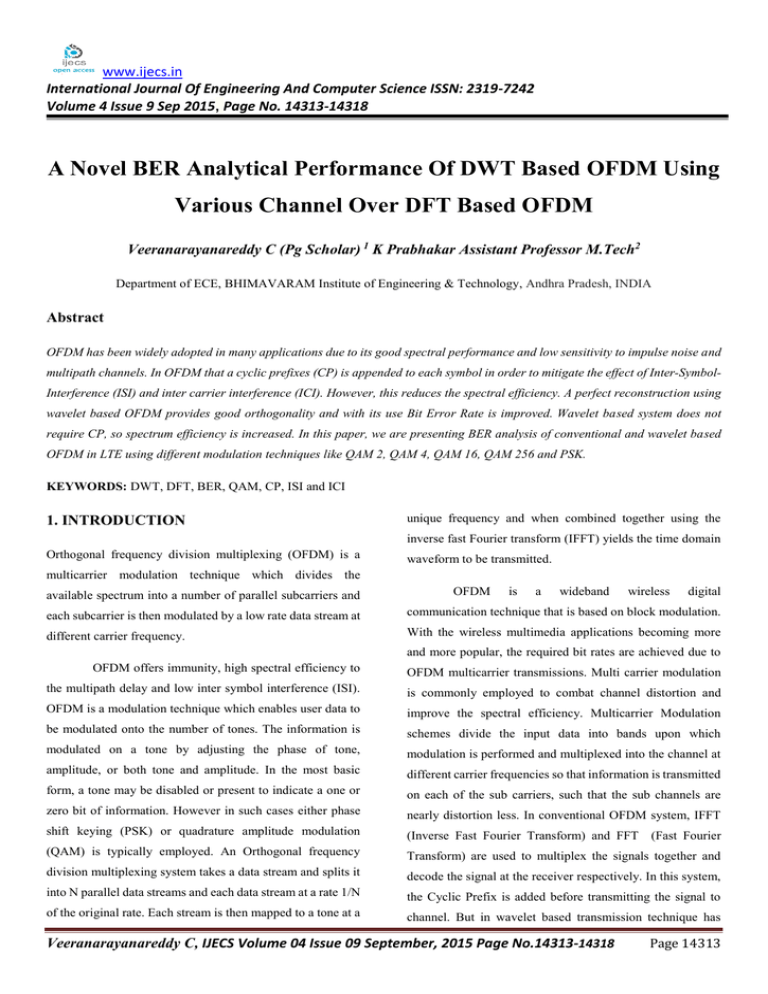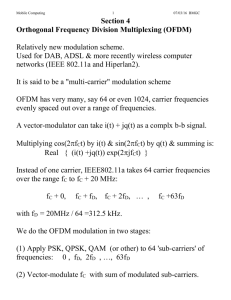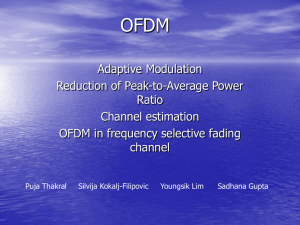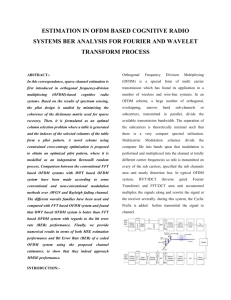www.ijecs.in International Journal Of Engineering And Computer Science ISSN: 2319-7242
advertisement

www.ijecs.in
International Journal Of Engineering And Computer Science ISSN: 2319-7242
Volume 4 Issue 9 Sep 2015, Page No. 14313-14318
A Novel BER Analytical Performance Of DWT Based OFDM Using
Various Channel Over DFT Based OFDM
Veeranarayanareddy C (Pg Scholar) 1 K Prabhakar Assistant Professor M.Tech2
Department of ECE, BHIMAVARAM Institute of Engineering & Technology, Andhra Pradesh, INDIA
Abstract
OFDM has been widely adopted in many applications due to its good spectral performance and low sensitivity to impulse noise and
multipath channels. In OFDM that a cyclic prefixes (CP) is appended to each symbol in order to mitigate the effect of Inter-SymbolInterference (ISI) and inter carrier interference (ICI). However, this reduces the spectral efficiency. A perfect reconstruction using
wavelet based OFDM provides good orthogonality and with its use Bit Error Rate is improved. Wavelet based system does not
require CP, so spectrum efficiency is increased. In this paper, we are presenting BER analysis of conventional and wavelet based
OFDM in LTE using different modulation techniques like QAM 2, QAM 4, QAM 16, QAM 256 and PSK.
KEYWORDS: DWT, DFT, BER, QAM, CP, ISI and ICI
1. INTRODUCTION
unique frequency and when combined together using the
inverse fast Fourier transform (IFFT) yields the time domain
Orthogonal frequency division multiplexing (OFDM) is a
waveform to be transmitted.
multicarrier modulation technique which divides the
available spectrum into a number of parallel subcarriers and
OFDM
is
a
wideband
wireless
digital
each subcarrier is then modulated by a low rate data stream at
communication technique that is based on block modulation.
different carrier frequency.
With the wireless multimedia applications becoming more
and more popular, the required bit rates are achieved due to
OFDM offers immunity, high spectral efficiency to
OFDM multicarrier transmissions. Multi carrier modulation
the multipath delay and low inter symbol interference (ISI).
is commonly employed to combat channel distortion and
OFDM is a modulation technique which enables user data to
improve the spectral efficiency. Multicarrier Modulation
be modulated onto the number of tones. The information is
schemes divide the input data into bands upon which
modulated on a tone by adjusting the phase of tone,
modulation is performed and multiplexed into the channel at
amplitude, or both tone and amplitude. In the most basic
different carrier frequencies so that information is transmitted
form, a tone may be disabled or present to indicate a one or
on each of the sub carriers, such that the sub channels are
zero bit of information. However in such cases either phase
nearly distortion less. In conventional OFDM system, IFFT
shift keying (PSK) or quadrature amplitude modulation
(Inverse Fast Fourier Transform) and FFT (Fast Fourier
(QAM) is typically employed. An Orthogonal frequency
Transform) are used to multiplex the signals together and
division multiplexing system takes a data stream and splits it
decode the signal at the receiver respectively. In this system,
into N parallel data streams and each data stream at a rate 1/N
the Cyclic Prefix is added before transmitting the signal to
of the original rate. Each stream is then mapped to a tone at a
channel. But in wavelet based transmission technique has
Veeranarayanareddy C, IJECS Volume 04 Issue 09 September, 2015 Page No.14313-14318
Page 14313
DOI: 10.18535/ijecs/v4i9.43
stronger ability of suppressing ISI and ICI than the
enough diversity and avoid the loss off all the signal in
conventional OFDM scheme. Two types of modulation
frequency selective fading environments. On the other hand
schemes are used in this paper which is Conventional and
much bandwidth means also much transmitting power. There
non-convention modulation schemes. BPSK, QPSK and
is a tradeoff between bandwidth and transmitted power.
QAM are the parts of conventional modulation schemes
The optimal bandwidth is found by channel
whereas Differential BPSK and Differential QPSK are the
nonconventional modulation schemes. BPSK is the one of the
simplest forms of digital modulation.The phase of the
constant amplitude carrier signal moves between zero and
180 degree. Differential PSK is a non coherent form of phase
shift keying which avoids the need for a coherent reference
signal at receiver. The non coherent receivers are easy and
cheap to build, and hence are widely used in wireless
communications [4]. The QPSK is a multilevel modulation
technique; it uses 2 bits per symbol to represent each phase.
Compared to BPSK, it is more spectrally efficient but
requires more complex receiver. In differentially-encoded
QPSK (DQPSK), the phase-shifts are 0°, 90°, 180°, -90°
corresponding to data '00', '01', '11', '10'. This kind of
simulations and field test trials. In Digital Audio
Broadcasting (DAB), for example, a bandwidth of 1.5 MHz
is a good compromise for the type of propagation conditions
that apply. We have seen that the greater the number of
carriers, the greater the symbol period on each carrier and so
less equalization is needed and the greater is the diversity
offered
by
the
system.
However,
with
differential
modulation, it is important that the channel dose not vary too
much during one symbol period. This is not the case when the
receiver is moving because of Doppler Effect and short term
fading. In such cases number of carriers will limit the moving
speed. This is another trade off of OFDM.
3. BASIC OFDM SYSTEM
encoding may be demodulated in the same way as for nondifferential PSK but the phase ambiguities can be ignored.
The block diagram of OFDM system is shown in fig.1.The
QAM is the method of combining two amplitude modulated
input high data rate streams are converted into number of low
signals into one channel. It may be an analogy QAM or a
data rate streams. This parallel stream is then modulated
digital QAM. Analogy QAM combines two amplitude
using QPSK or QAM modulation techniques, which is then
modulated signals using the same carrier frequency with a 90
applied as input to IFFT block producing OFDM samples.
degree phase difference. Adaptive channel equalizers utilize
These samples are then converted into OFDM signal using
channel estimates to overcome the effects of inter symbol
Parallel-to-Serial converter (P/S).The signal is then encoded
interference. Diversity techniques utilize the channel estimate
by adding Cyclic Prefix (CP) and is then transmitted over the
to implement a matched filter such that the receiver is
channel. The reverse process is done at the receiver
optimally matched to the received signal instead of the
transmitted one. Maximum likelihood detectors utilize
S/P and
modulation
IFFT
P/S
Converter
channel estimates to minimize the error probability. One of
Add
CP
Channel
the most important benefits of channel estimation is that it
allows the implementation of coherent demodulation.
P/S and
modulation
FFT
S/P
Converter
Rem
CP
IFFT
P/S
Converter
Add
CP
Coherent demodulation requires the knowledge of the phase
of the signal.
S/P and
modulation
2. OFDM SYSTEM DESIGN
Occupied bandwidth is of course directly related to the data
rate to transmit. However, the question is, what is the
minimum bandwidth required to be taken in order to obtain
Channel
P/S and
modulation
FFT
S/P
Converter
Rem
CP
Figure 1: Block diagram of Basic OFDM system
Veeranarayanareddy C, IJECS Volume 04 Issue 09 September, 2015 Page No.14313-14318
Page 14314
DOI: 10.18535/ijecs/v4i9.43
Wavelet rework could be a tool for analysis of the signal in
4. CONVENTIONAL OFDM SYSTEMS
time and frequency domain together. it's a multi resolution
Orthogonal Frequency Division Multiplexing (OFDM) is a
analysis mechanism wherever signal is rotten into completely
multicarrier modulation technique in which the spectrum of
different frequency elements for the analysis with explicit
the subcarriers overlap on each other. The frequency spacing
resolution matching to scale . Using any explicit sort of ripple
among them is selected in such a way that orthogonality is
filter the system will be designed in line with the necessity
achieved among the subcarriers.
and additionally the multi resolution signal will be generated
For typical OFDM system sinusoids of DFT type
associate orthogonal basis perform set. In DFT the remodel
correlates its signaling with every of curving basis perform ,
here orthogonal basis functions are the subcarriers utilized in
OFDM. At the receiver the signals are combined to get the
information transmitted. much, quick Fourier remodel (FFT)
and Inverse quick Fourier remodel (IFFT) are used for the
implementation of the OFDM system as a result of less range
of computations needed in FFT and IFFT. Multiple replicas
of the signal are received at the receiver finish attributable to
the time dispersive nature of the channel, thus frequency
selective fading results and to scale back this interference
guard interval is used, that is termed cyclic prefix . Cyclic
by the utilization of wavelets. By the utilization of varying
ripple filter, one will style waveforms with selectable
time/frequency partitioning for multi user application.
Wavelets possess higher orthogonality and have localization
each in time and frequency domain. To cut back international
intelligence agency and ICI in typical OFDM system use of
cyclic prefix is there, that uses 2 hundredth of available
information measure, therefore leads to information measure
unskillfulness however this cyclic prefix isn't needed in ripple
primarily based OFDM system. quality also can be reduced
by victimization ripple transform as compared with the
Fourier rework as a result of in wavelet quality is O[N] as
compared with quality of Fourier rework of O[N log2 N] .
ripple primarily based OFDM is simple and also the DFT
prefix is copy of the some fraction of image finish.
primarily based OFDM is complicated. Wavelet based
As long because the channel delays unfold remains
OFDM is versatile further and since higher orthogonality is
among the limit of the cyclic prefix there would not be any
provided by it, there's no a need of cyclic prefixing in ripple
loss in orthogonality. For LTE, in the downlink information
primarily based OFDM that is needed in DFT based OFDM
of various users is multiplexed in frequency domain and
to take care of orthogonality therefore ripple based system is
access technique is termed Orthogonal Frequency Division
a lot of information measure economical as compared with
Multiple Access (OFDMA). Within the transmission of the
the DFT based OFDM.
LTE access technique used is Single Carrier-Frequency
Division Multiple Access (SC-FDMA). High Peak Average
Power quantitative relation (PAPR) happens because of
random constructive addition of subcarriers and leads to
spectrum spreading of signal resulting in adjacent channel
interference.
So
power
linearization
techniques
and
compression purpose electronic equipment got to be wont to
overcome this downside.
In distinct ripple rework (DWT), signal presented can
experience many completely different filters and can be
decomposed into low pass and high pass bands through the
filters. throughout decomposition the high pass filter can take
away the frequencies below 1/2 the best frequency and low
pass filter can take away frequencies that area unit on top of
1/2 the highest frequency. The decomposition halves the time
resolution as a result of 1/2 the samples area unit accustomed
5. WAVELET BASED OFDM SYSTEM
characterize the signal equally frequency resolution are
doubled and this decomposition method are perennial once
In previous works use of distinct Fourier rework was
more for getting the ripple coefficients of needed level. 2
proposed for the implementation of OFDM. Wavelet
forms of coefficients area unit obtained through process, 1st
transform show the potential to switch the DFT in OFDM.
ones area unit called elaborated coefficients obtained through
Veeranarayanareddy C, IJECS Volume 04 Issue 09 September, 2015 Page No.14313-14318
Page 14315
DOI: 10.18535/ijecs/v4i9.43
high pass filter and second ones area unit referred to as coarse
7. SIMULATION RESULTS
approximations obtained through low pass filter connected
with scaling method. After passing the info through filters the
By using MATLAB performance characteristic
destruction method are performed. the entire procedure can
of DFT based OFDM and wavelet based OFDM are obtained
continue till the required level is obtained.
for different modulations that are used for the LTE, as shown
in figures 3-5. Modulations that could be used for LTE are
6. PROPOSED WAVELET BASED OFDM
QPSK, 16 QAM and 64 QAM (Uplink and downlink). QPSK
DESIGN
does not carry data at very high speed. When signal to noise
ratio is of good quality then only higher modulation
In this proposed model we are using IDWT
and DWT at the place of IDFT and DFT. AWGN channel is
techniques can be used. Lower forms of modulation (QPSK)
does not require high signal to noise ratio.
used for transmission and cyclic prefixing is not used. Here
For the purpose of simulation, signal to noise ratio
first of all conventional encoding is done followed by
(SNR) of different values are introduced through AWGN
interleaving then data is converted to decimal form and
channel. Data of 9600 bits is sent in the form of 100 symbols,
modulation is done next. After modulation the pilot insertion
so one symbol is of 96 bits. Averaging for a particular value
and sub carrier mapping is done then comes the IDWT of the
of SNR for all the symbols is done and BER is obtained and
data, which provides the orthogonality to the subcarriers.
same process is repeated for all the values of SNR and final
IDWT will convert time domain signal to the frequency
BERs are obtained.
domain. After passing through the channel on the signal
Firstly the performance of DFT based OFDM and
DWT will be performed and then pilot synchronization where
wavelet based OFDM are obtained for different modulation
the inserted pilots at the transmitter are removed then the
techniques. Different wavelet types daubechies2 and haar is
demodulation is done.
used in wavelet based OFDM for QPSK, 16-QAM, 64-QAM.
BER analysis using QPSK modulation
0
10
Haar
db2
DFT
Data Encoding
Interleaving
IDWT
Carrier
Mapping
Modulation
-1
10
-2
10
Pilot Insertion
-3
10
0
1
2
3
4
5
6
.
AWGN Channel
Figure 3: BER performance of wavelets and DFT based
DWT
Demapping
Pilot
Synchronizatio
n
OFDM system using QPSK modulation
BER analysis using 64-QAM modulation
Haar
db2
DFT
-0.4
10
Data Decoding
De
interleaving
Demodulation
Figure 2: Wavelet based proposed OFDM system design
-0.5
10
Demodulated data is converted to binary form and
the de-interleaved and decoded to obtain the original data
0
2
4
6
8
10
12
transmitted.
Veeranarayanareddy C, IJECS Volume 04 Issue 09 September, 2015 Page No.14313-14318
Page 14316
DOI: 10.18535/ijecs/v4i9.43
Figure 4: BER performance of wavelets and DFT based
proposed work we use estimated DWT based OFDM
OFDM system using 64- QAM modulation
algorithm for BER Performance using Rician, Rayleigh and
AWGN channel. Estimation of BER Performance is done by
BER vs SNR using 16 QAM
0
10
DWT-Haar
DWT-db2
FFT
using the SUI channel for better performance, High spectral
BER
efficiency and low run time complexity.
-1
10
9. REFERENCES
-2
10
0
2
4
6
SNR
8
10
[1] A. Ian F., G. David M., R. Elias Chavarria, “The evolution
12
to
Figure 5: BER performance of wavelets and DFT based
OFDM system using 16-QAM modulation
BER analysis using QPSK modulation
0
4G
cellular
systems:
Physical
LTE-advanced”,
communication, Elsevier, vol. 3, no. 4, pp. 217-244, Dec.
2010.
[2] B. John A. C., “Multicarrier modulation for data
10
Haar
db2
DFT
transmission: an idea whose time has come”, IEEE
Communications magazine, vol. 28, no. 5, pp. 5-14, May
1990.
-1
10
[3] L. Jun, T. Tjeng Thiang, F. Adachi, H. Cheng Li, “BER
performance of OFDM-MDPSK system in frequency
selective rician fading and diversity reception” IEEE
-2
10
0
1
2
3
4
5
6
Figure 6: SUI model QPSK modulation scheme
8. CONCLUSION
Transactions on Vehicular Technology, vol. 49, no. 4, pp.
1216-1225, July 2000.
[4] K. Abbas Hasan, M. Waleed A., N. Saad, “The
performance of multiwavelets based OFDM system under
different channel conditions”, Digital signal processing,
In this paper we have a tendency to analyzed the
performance of rippling primarily {based} OFDM system
and compared it with the performance of DFT based OFDM
system. From the performance curve we've determined that
the BER curves obtained from rippling primarily {based}
OFDM area unit higher than that of DFT based OFDM. we
have a tendency to used 3 modulation techniques for
implementation that area unit QPSK, 16QAM and 64QAM,
that area unit utilized in LTE. In rippling based mostly OFDM
differing kinds of filters are often used with the assistance of
various wavelets offered. We’ve used daubechies2 and haar
wavelets, each offer their best performances at totally
different intervals of SNR.
EXTENSION
Elsevier, vol. 20, no. 2, pp. 472- 482, March 2010.
[5] K. Volkan, K. Oguz, “Alamouti coded wavelet based
OFDM for multipath fading channels”, IEEE Wireless
telecommunications symposium, pp.1-5, April 2009.
[6] G. Mahesh Kumar, S. Tiwari, “Performance evaluation of
conventional
and
wavelet
based
OFDM
system”,
International journal of electronics and communications,
Elsevier, vol. 67, no. 4, pp. 348-354, April 2013.
[7] J. Antony, M. Petri, “Wavelet packet modulation for
wireless communication”, Wireless communication &
mobile computing journal, vol. 5, no. 2, pp. 1-18, March
2005.
[8] L. Madan Kumar, N. Homayoun, “A review of wavelets
for digital wireless communication”, Wireless personal
communications, Kluwer academic publishers- Plenum
The BER ANALYSIS improvement is a challenging task in
publishers, vol. 37, no. 3-4, pp. 387-420, May 2006.
the orthogonal frequency division multiplexing, in our
Veeranarayanareddy C, IJECS Volume 04 Issue 09 September, 2015 Page No.14313-14318
Page 14317
DOI: 10.18535/ijecs/v4i9.43
[9] L. Alan, “Wavelet packet modulation for orthogonally
[11] IEEE std., IEEE proposal for 802.16.3, RM wavelet
multiplexed communication”, IEEE transaction on signal
based (WOFDM), PHY proposal for 802.16.3, Rainmaker
processing, vol. 45, no. 5, pp. 1336-1339, May 1997.
technologies, 2001.
[10] K. Werner, P. Gotz, U. Jorn, Z Georg, “A comparison of
[12] O. Eiji, I Yasunori, I Tetsushi, “Multimode transmission
various MCM
using wavelet packet modulation and OFDM”, IEEE
schemes”, 5th International OFDM-workshop, Hamburg,
vehicular technology conference, vol. 3, pp. 1458-1462, Oct.
Germany, pp. 20-1 – 20-5, July 2000.
2003.
Veeranarayanareddy C, IJECS Volume 04 Issue 09 September, 2015 Page No.14313-14318
Page 14318


